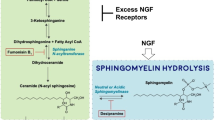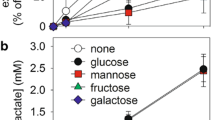Abstract
Aiming to investigate the possible production of ceramide-1-phosphate from complex sphingolipid metabolism in neurons, we administered radiolabeled sphingolipids to cerebellar granule cells and inspected the formation of labeled ceramide-1-phosphate in different experimental conditions. We report that differentiated granule cells are capable to form Cer-1-P via ceramide derived from SM degradation at the plasma membrane level. Moreover we observed that ceramide-1-phosphate can be also produced from a metabolic pathway not involving SM degradation. In particular, we obtained evidence that ceramide, synthesized via the recycling of sphingosine produced from ganglioside catabolism, can also be the precursor of ceramide-1-phosphate. We also found that undifferentiated and differentiated granule cells display different capacities to phosphorylate Cer produced by the two different metabolic pathways. The results here obtained demonstrate that cerebellar neurons are able to metabolically produce ceramide-1-phosphate and support that this molecule may serve a potential role in sphingoid-mediated signaling in the nervous system.
Similar content being viewed by others
REFERENCES
Riboni, L., Viani, P., Bassi, R., Prinetti, A., and Tettamanti, G. 1997. The role of sphingolipids in the process of signal transduction. Prog. Lipid Res. 36:153-195.
Perry, D. K. and Hannun, Y. A. 1998. The role of ceramide in cell signaling. Biochim. Biophys. Acta 1436:233-243.
Kolesnick, R. N. and Krönke, M. 1998 Regulation of ceramide production and apoptosis. Annu. Rev. Physiol. 60:643-665.
Spiegel, S., Cuvillier, O., Edsall, L., Kohama, T., Menzeleev, R., Olivera, A., Thomas, D., Tu, Z., Van Brocklyn, J. R., and Wang, F. 1998. Roles of sphingosine-1-phosphate in cell growth, differentiation and death. Biochem. (Moscow) 63:69-73.
Hannun, Y., Luberto, C., and Argraves, K. M. 2001. Enzymes of sphingolipid metabolism: From modular to integrative signaling. Biochem. 40:4893-4903.
Bajjalieh, S., Martin, T. F. J., and Floor, E. 1989. Synaptic vesicle ceramide kinase. A calcium-stimulated lipid kinase that co-purifies with brain synaptic vesicles. J. Biol. Chem. 264: 14354-14360.
Dressler, K. A. and Kolesnick, R. N. 1990. Ceramide 1-phosphate, a novel phospholipid in human leukemia (HL-60) cells. Synthesis via ceramide from sphingomyelin. J. Biol. Chem. 264:14917-14921.
Kolesnick, R. N. and Hemer, M. R. 1990. Characterization of ceramide kinase activity from human leukemia (HL-60) cells. J. Biol. Chem. 265:18803-18808.
Hedlund, M., Svensson, M., Nilsson, A., Duan, R.-D., and Svanborg, C. 1996. Role of the ceramide-signaling in cytokine responses to P-fimbriated Escherichia Coli. J. Exp. Med. 183: 1037-1044.
Hinkovska-Galcheva, V. T., Boxer, L. A., Mansfield, P. J., Harsh, D., Blackwood, A., and Shayman, J. A. 1998. The formation of ceramide-1-phosphate during neutrophil phagocytosis and its role in liposome fusion. J. Biol. Chem. 273:33203-33209.
Gómez-Muñoz, A., Abousalham, A., Kikuchi, Y., Waggoner, D. W., and Brindley, D. N. 1997. Role of sphingolipids in regulating the phospholipase D pathway and cell division. Pages 103-120, in Hannun, Y. A. (ed.), Sphingolipid-Mediated Signal Transduction, Springer-Verlag GmbH, Heidelberg, Germany.
Frago, L. M., León, Y., de la Rosa, E. J., Gómez-Muñoz, A., and Varela-Nieto, I. 1998. Nerve growth factor and ceramides modulate cell death in the early developing inner ear. J. Cell Science 111:549-556.
Zheng, T., Li, W., Wang, J., and Altura, B. T. 2000. Effects of neutral sphingomyelinase on phenylephrine-induced vasoconstriction and Ca2+ mobilization in rat aortic smooth muscle. Eur. J. Pharmacol. 391:127-135.
Shinghal, R., Scheller, R. H., and Bajjalieh, S. M. 1993. Ceramide-1-phosphate phosphatase activity in brain. J. Neurochem. 61:2279-2285.
Sonnino, S., Chigorno, V., and Tettamanti, G. 2000. Preparation of radioactive gangliosides, 3H or 14C isotopically labeled at oligosaccharide or ceramide moieties. Methods Enzymol. 311:639-656.
Riboni, L., Bassi, R., Sonnino, S., and Tettamanti, G. 1992. Formation of free sphingosine and ceramide from exogenous ganglioside GM1 by cerebellar granule cells in culture. FEBS Lett. 300:188-192.
Iwamori, M., Moser, H. W., Kishimoto, Y. 1975. Specific tritium labeling of cerebrosides at the 3-positions of erythrosphingosine and threo-sphingosine. J. Lipid Res. 16:332-336.
Brindley, D. N., Xu, J., Jasinska, R., and Waggoner, D. W. 2000. Analysis of ceramide-1-phosphate and sphingosine-1-phosphate phosphatase activity. Methods Enzymol. 311:233-244.
Riboni, L., Viani, P., and Tettamanti, G. 2000. Estimating sphingolipid metabolism and trafficking in cultured cells using radiolabeled compounds. Methods Enzymol. 311:656-682.
Gallo, V., Ciotti, M. T., Coletti, A., Aloisi, F., and Levi, G. 1982. Selective release of glutamate from cerebellar granule cells differentiating in culture. Proc. Natl. Acad. Sci. U.S.A. 79: 7919-7923.
Riboni, L., Bassi, R., Prinetti, A., and Tettamanti, G. 1996. Salvage of catabolic products in ganglioside metabolism: A study on rat cerebellar granule cells in culture. FEBS Lett. 391: 336-340.
Riboni, L. and Tettamanti, G. 1991. Rapid internalization and intracellular processing of exogenous ganglioside by cerebellar granule cells differentiated in culture. J. Neurochem. 57: 1931-1939.
Riboni, L., Bassi, R., Conti, M., and Tettamanti, G. 1993. Metabolism of exogenous ganglioside GM1 in cultured cerebellar granule cells. The fatty acid and the sphingosine moieties formed during degradation are re-used for lipid biosynthesis. FEBS Lett. 322:257-260.
Riboni, L., Bassi, R., Prinetti, A., Viani, P., and Tettamanti, G. 1999. Predominance of the acylation route in the metabolic processing of exogenous sphingosine in neural and extraneural cells in culture. Biochem. J. 338:147-151.
Riboni, L., Viani, P., Bassi, R., Giussani, P., and Tettamanti, G. 2000. Cultured granule cells and astrocytes from cerebellum differ in metabolizing sphingosine. J. Neurochem. 75:503-510.
Riboni, L., Prinetti, A., Bassi, R., and Tettamanti, G. 1994. Formation of bioactive sphingoid molecules from exogenous sphingomyelin in primary cultures of neurons and astrocytes. FEBS Lett. 352:323-326.
Bajjalieh, S. and Batchelor, R. 2000. Ceramide kinase. Methods Enzymol. 311:207-215.
Author information
Authors and Affiliations
Rights and permissions
About this article
Cite this article
Riboni, L., Bassi, R., Anelli, V. et al. Metabolic Formation of Ceramide-1-Phosphate in Cerebellar Granule Cells: Evidence for the Phosphorylation of Ceramide by Different Metabolic Pathways. Neurochem Res 27, 711–716 (2002). https://doi.org/10.1023/A:1020236419556
Issue Date:
DOI: https://doi.org/10.1023/A:1020236419556




